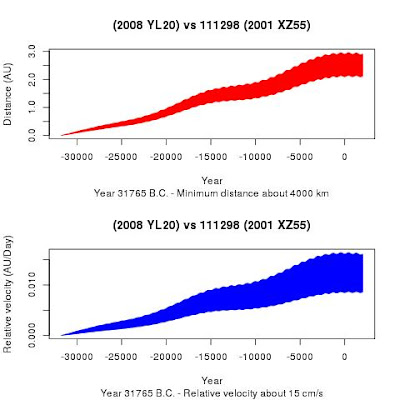I wonder whether Hilda asteroid (2017 OC9) was once a comet.
Almost two months ago, there was a nice example of a Hilda asteroid that showed a cometary activity:
Cometary behaviour of Hilda asteroid (457175) 2008 GO98
As described here by GAMP's (Gruppo Astrofili Montagna Pistoiese, i.e. Pistoia Mountains Astronomical Observatory - MPC code 104) member Paolo Bacci, on
the night of July 3rd, 2017, Mt. Lemmon Survey (G96) found that
a Hilda asteroid (457175) 2008 GO98, at the time with a brightness of ~16.5 mag, showed a
widespread 7/8" coma and a tail with a length of ~15" with PA 260°.
Observations were subsequently confirmed by the observatory of the Steward Observatory, Mt. Lemmon Station (I52).
The Minor Planet Center on the same day published MPEC 2017-N50, announcing the asteroid cometary activity.
From the Pistoia Mountain Astronomical Observatory (code MPC 104), GAMP
members Paolo Bacci and Martina Maestripieri captured 50 images of the asteroids and they found that the asteroid showed a diffused ~ 16''
arc coma and a long tail ~ 15.3" .
This fact is not completely unexpected.
As described in the paper "Comet candidates among quasi-Hilda objects", there is a dynamical criteria to identify potential candidates in the unstable quasi-Hilda region, the so called Toth rule based on the calculation of horizontal and vertical components (k,h) of eccentricity in Lagrangian elements.
In that paper Asteroid (457175) 2008 GO98 was identified as a potential candidate.
More about the nature of this object can be found in this article (thanks to David Rich for showing me his blog).
More about the nature of this object can be found in this article (thanks to David Rich for showing me his blog).
Hilda asteroid (2017 OC9)
It seems to me that this Hilda object satisfies the Toth rule so it might be a candidate to be an extinct comet .
I made a simulation using the Mercury6 simulator ("A Hybrid Symplectic Integrator that Permits Close Encounters between Massive Bodies''. Monthly Notices of the Royal Astronomical Society, vol 304, pp793-799.).
The object uncertainty is still extremely high (orbit condition code 9), so the simulation based only on the nominal parameters is far from being conclusive; anyway, just to have an idea of the possible behaviour, it seems that the object could have arrived from the outskirts of the solar system (100 AU) about 1,2 Millions years ago.
I would be interested to know from expert astromomers if this is a real possibility and if they think that this case deserves a deeper analysis when the orbit will be better known.
Kind Regards,
Alessandro Odasso



